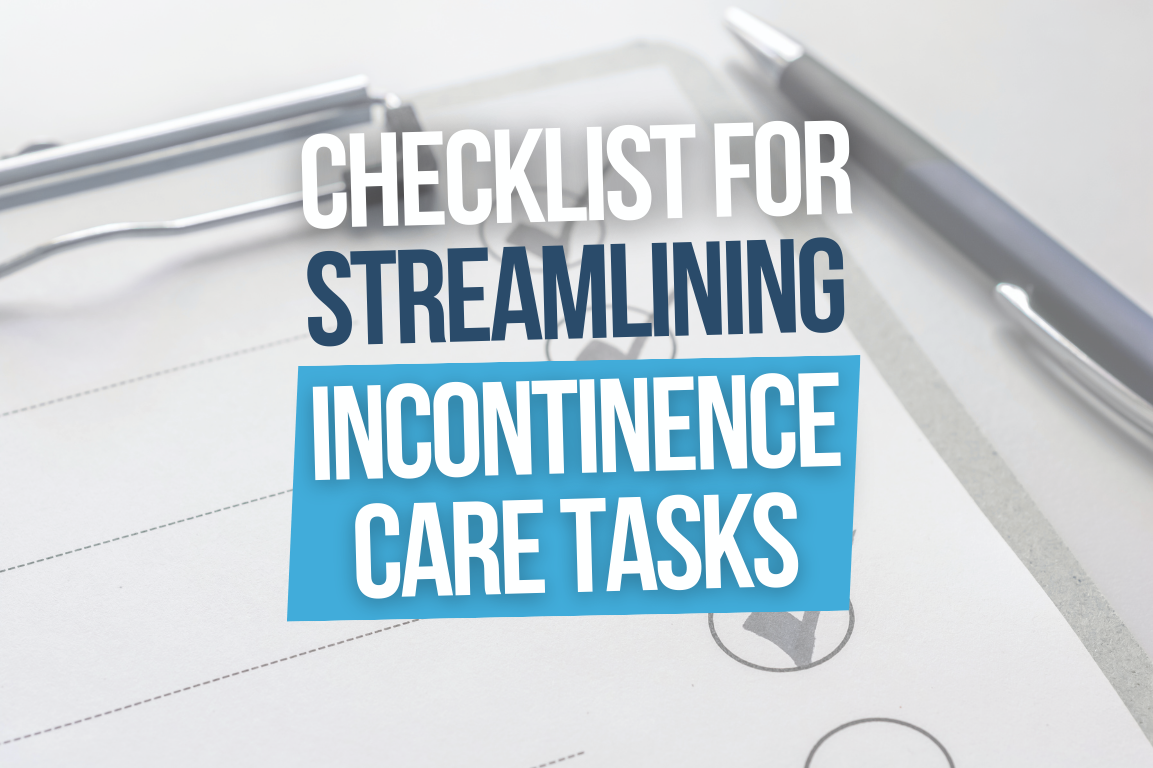Checklist for Streamlining Incontinence Care Tasks

Caring for someone with incontinence can feel overwhelming, but a well-organized system can make it easier and less stressful. This checklist focuses on practical steps to simplify daily care, maintain hygiene, and improve efficiency while respecting the dignity of the person receiving care.
Key Takeaways:
- Preparation Matters: Assess needs, stock supplies (like absorbent products and disposable bed sheets), and organize a safe care space.
- Daily Routines: Use easy-to-change clothing, portable solutions (like bedside commodes), and mobile supply stations to minimize disruptions.
- Hygiene & Skin Care: Follow proper cleaning steps, use barrier creams, and monitor skin condition to prevent irritation or infections.
- Time Management: Group tasks, keep supplies accessible, and use time-saving products like disposable bed sheets to reduce workload.
By focusing on these steps, caregiving becomes more manageable, allowing you to spend more meaningful time with those you care for.
CNA Skill: Perineal Care on a Male Resident
Preparation and Planning: Getting Ready for Care Tasks
Getting organized is key to managing incontinence care effectively. Take time to evaluate needs, gather all necessary supplies, and create a well-organized care space to make the process smoother and less stressful.
Assess Individual Needs
Before setting up a care routine, it’s important to understand the specific type and severity of incontinence. A thorough continence assessment can help identify the best care strategies and products for the individual.
Approach conversations about incontinence with sensitivity and respect. Talk openly to understand their feelings, concerns, and any strategies they’re already using. These discussions can help build trust and provide valuable insights.
Keep detailed records, including medical history, continence patterns, and any medications (both prescription and over-the-counter, as well as supplements). Tools like a bladder and bowel diary or an observation chart can help track patterns. For individuals with cognitive challenges, caregivers may need to rely on observation charts to gather this information.
Pay attention to dietary and fluid intake. Note the types and amounts of beverages consumed daily - caffeine and alcohol can worsen symptoms, while insufficient hydration can lead to dehydration or constipation. These details can guide you in choosing the most suitable care products and strategies.
Gather Needed Supplies
Having the right supplies on hand can make care tasks more efficient and less stressful. What you’ll need depends on the individual’s specific needs and the severity of their incontinence.
Stock up on absorbent products in various levels of absorbency, such as pads, protective underwear, or briefs. Protect surfaces like mattresses, chairs, and car seats with waterproof covers, and have hygiene essentials ready, including disposable wipes, barrier creams, and gloves for caregiver protection. Products like PeelAways disposable waterproof bed sheets can simplify cleanup without requiring heavy lifting.
In some cases, specialized devices such as urinary catheters, penile sheaths, or portable urinals may be necessary. These should only be used under the guidance of a healthcare provider.
Once supplies are prepared, focus on organizing your care environment.
Set Up a Safe Care Space
A well-organized care space can make all the difference. Start by removing hazards, ensuring the area is well-lit, and adding aids like grab bars and non-slip mats. Keep frequently used items within easy reach, and make sure pathways are clear to accommodate mobility aids.
Other environmental factors can also impact incontinence management. For instance, ensure there’s enough space around toilets and beds for walkers or wheelchairs. Flooring should provide good traction to prevent slips, and clear signage marking bathroom locations can be especially helpful for individuals with cognitive challenges.
Daily Care Tasks: Making Routines More Efficient
With some thoughtful preparation, you can make daily incontinence care less stressful and more dignified. Here are practical tips to simplify clothing changes, improve mobility, and maintain privacy, ensuring a smoother daily routine.
Make Clothing and Bed Changes Easier
Choose easy-to-use clothing with features like velcro closures, snap fasteners, or magnetic buttons. These options are much simpler than traditional zippers or buttons, especially for individuals with limited mobility. Side-opening pants and back-opening shirts can make dressing and undressing quicker and less challenging. For added comfort, go for moisture-wicking fabrics such as breathable cotton blends, and avoid tight-fitting clothes that may restrict circulation.
Simplify bedding changes with innovative products designed for speed and convenience. Instead of struggling with heavy mattress lifting, try PeelAways disposable waterproof bed sheets. These come in various sizes and feature a patented multi-layer design - you just peel off the top layer to reveal a fresh sheet underneath. This eliminates the need for laundry and reduces the risk of cross-contamination.
Keep essentials close by to save time and effort. Stock clean clothing, protective products, and hygiene items in a bedside organizer or rolling cart. This setup ensures you have everything you need within reach, allowing you to make quick changes without leaving the person unattended.
These small adjustments can make a big difference in creating a more efficient and manageable care routine.
Use Portable Solutions to Reduce Disruption
Portable commodes are a practical option for individuals who struggle to reach the bathroom quickly, especially during the night. Modern designs are lightweight, stable, and easy to use, making them a great addition to nighttime care routines.
Bedside urinals can be a game-changer for men who can use them independently. These allow for more control and reduce the urgency of bathroom trips. Look for models with secure lids and easy-to-grip handles for added convenience.
Create mobile supply stations by using wheeled carts that can move between rooms. Stock them with essentials like protective products, wipes, barrier creams, and disposal bags. This eliminates the need for multiple trips and keeps everything organized in one place.
Use waterproof lap pads during meals or activities to protect clothing and furniture without the need for more intrusive full-body coverings. These pads are discreet and easy to use while adding an extra layer of protection.
By combining portable solutions with efficient clothing and bedding adjustments, you can make care less disruptive and more respectful.
Maintain Dignity and Privacy
Communicate clearly during care by explaining each step and asking for permission before touching or moving the person. This approach helps maintain their sense of autonomy and respect.
Offer choices whenever possible, whether it’s about the timing of care, clothing options, or other preferences. Even small decisions can help the individual feel more in control.
Ensure privacy by closing doors, using privacy screens, and minimizing the number of people present during care. Cover areas of the body not being cared for with towels or blankets to maintain modesty.
Take your time and proceed at a pace that feels comfortable for the individual. Rushing can feel disrespectful and may add unnecessary stress.
Engage in appropriate conversation when suitable. Talking about their interests or current events can help normalize the experience while respecting their mood and preferences.
Honor personal preferences regarding caregiver gender or specific family members. Respecting these choices shows consideration for their dignity and comfort.
This respectful and compassionate approach ensures that care tasks are not only efficient but also considerate, balancing practicality with empathy.
sbb-itb-45288fe
Hygiene and Skin Care: Preventing Problems
Maintaining proper hygiene and taking care of the skin are essential for avoiding complications like infections, irritation, or discomfort. A consistent routine not only helps protect the skin but also ensures overall comfort and well-being. By following a few key steps, you can prevent issues before they escalate.
Follow Proper Cleanup Steps
Prioritize hand hygiene and use disposable gloves to reduce the risk of spreading bacteria. Wash your hands thoroughly before and after care, and wear nitrile or vinyl gloves to protect both yourself and the person you're assisting. Always change gloves between tasks and dispose of them immediately after use.
Use a pH-balanced, gentle cleanser designed for sensitive skin instead of regular soap, which can strip the skin's natural barrier. No-rinse cleansers or pre-moistened wipes with soothing ingredients like aloe vera are great options for quick and gentle cleaning.
Clean from front to back to avoid spreading bacteria to sensitive areas. After cleansing, pat the skin dry gently - don’t rub, as this can cause irritation. Let the skin air dry for a few moments before applying any protective products or new incontinence supplies.
Dispose of soiled materials properly by sealing them in bags to contain odors and prevent contamination. Keep a small trash can with a tight-fitting lid nearby, and make it a habit to empty it frequently.
Sanitize surfaces and equipment after every use. Clean items like portable commodes, bed rails, and any other equipment that may have come into contact with bodily fluids. Regular disinfection ensures a clean environment and reduces the risk of infection.
Protect and Monitor Skin Health
Apply a barrier cream containing zinc oxide or dimethicone after thoroughly cleaning and drying the skin. This creates a protective layer and helps prevent irritation. Reapply as needed, especially after each cleanup.
Inspect the skin daily for any signs of redness, irritation, or breakdown. Pay close attention to areas prone to moisture, such as the buttocks, inner thighs, and genital region. Early detection of changes can prevent more serious issues from developing.
Be alert for warning signs like redness that doesn’t fade within 30 minutes, small skin cracks, unusual warmth in specific areas, or open sores. Document these observations and reach out to healthcare providers if needed.
Encourage air circulation by allowing short periods without protective garments. Even 15-20 minutes of air exposure during routine care can help improve skin health. Opt for breathable, moisture-wicking fabrics for clothing, and consider products designed to enhance airflow.
Support skin repair with proper hydration and nutrition. Ensure adequate water intake and include protein-rich foods in the diet. If dietary challenges exist, consult a healthcare provider about supplements or other nutritional options.
Keep detailed records of skin condition, care routines, and any changes you notice. These notes can help identify patterns and are invaluable when discussing care plans with healthcare professionals.
Time Management and Organization: Working More Efficiently
When it comes to caregiving, staying organized and managing time wisely can make all the difference. With smart strategies and efficient tools, you can cut down on the time spent on care tasks and focus more on what truly matters - providing quality support while reducing stress.
Organize Supplies for Easy Access
Set up a care station in the room where care is most often provided - typically the bedroom or bathroom. A rolling cart or portable caddy stocked with essentials like gloves, wipes, barrier creams, fresh undergarments, and disposal bags ensures everything you need is always within reach. This eliminates the hassle of searching for items during critical moments.
Use clear, labeled containers to keep supplies organized and easy to find. Drawer organizers or small bins can help separate different types of products. Keep frequently used items at eye level and close by to save time during care routines.
Maintain a backup supply system by storing extras in a nearby cabinet or closet. When an item runs out at your care station, you can quickly replenish it without disruption.
Place mini kits in key areas like the bathroom or bedside. Having essentials readily available in multiple locations ensures you're always prepared and aligns with the goal of creating smooth, dignified care routines.
Group Related Tasks Together
Combine tasks like clothing and bedding changes whenever possible. Handling both at the same time reduces interruptions and streamlines the caregiving process.
Plan routine care tasks around natural transitions such as before meals or bedtime. For example, batch activities like restocking supplies, doing laundry, or cleaning equipment during these moments. Predictable patterns not only make routines less intrusive but also help consolidate efforts.
Coordinate care with daily routines like bathing or dressing. Grouping similar tasks together minimizes the number of transitions and reduces the overall time needed for care. These small adjustments can make a big difference in efficiency.
Use Time-Saving Products
Simplify cleanup with PeelAways disposable bed sheets. These sheets cut down on laundry and eliminate the need for heavy lifting or full bed stripping, saving time and effort.
Opt for products designed for efficiency in other areas of care. For instance, no-rinse cleansers eliminate the need for extra water and towels, while barrier creams with built-in cleansing properties combine steps in your routine.
Invest in effective disposal systems like odor-sealing bags or small trash cans with secure lids placed strategically around care areas. These systems help manage waste efficiently, prevent odors, and reduce trips to larger trash bins.
Take advantage of subscription services for regularly needed supplies. Services like PeelAways' subscription options ensure you always have fresh bed protection on hand, cutting down on shopping trips and ensuring you're never caught without essentials.
Conclusion: Improve Your Care Routine with This Checklist
This checklist pulls together practical steps to simplify caregiving, from preparation to daily tasks. By focusing on preparation, organization, and the right tools, you can turn what feels like an overwhelming workload into a manageable routine.
Start by assessing care needs and gathering supplies ahead of time - this avoids last-minute scrambling and keeps things running smoothly. Good organization not only saves time but also creates a more peaceful environment for everyone.
Streamlining your routine helps maintain dignity for those you care for while reducing physical strain on yourself. Small adjustments, like grouping similar tasks or using time-saving products such as PeelAways disposable bed sheets, can make a big difference in efficiency without compromising care quality.
Prioritizing hygiene and skin care is crucial for preventing complications and supporting overall health.
Every part of this checklist works together to create a caregiving routine that is both effective and respectful. When your supplies are in order, tasks are grouped wisely, and you rely on tools that simplify the process, you can focus less on logistics and more on providing meaningful, compassionate care.
Use this checklist to ease the stress of caregiving and improve care standards. Start small - pick one or two strategies today - and build a routine that works for you and those you care for.
FAQs
How do I choose the right incontinence care products for someone's specific needs?
Choosing the right incontinence care products begins with understanding the specific needs of the individual. Start by evaluating the level of incontinence - whether it's light, moderate, or severe - as well as any mobility challenges and skin sensitivity. Getting accurate waist and hip measurements ensures a proper fit, while considering daily routines and personal preferences can help determine whether reusable or disposable products are the better choice.
Comfort and skin health should always be top priorities. Look for products with the right absorbency levels and materials that are gentle on the skin. If possible, try out product samples to find options that balance effectiveness with ease of use. The goal is to choose products that not only simplify caregiving but also support the individual's comfort and dignity.
How can caregivers maintain dignity and privacy when providing incontinence care?
Maintaining dignity and privacy during incontinence care is all about ensuring the individual feels respected and comfortable. Begin by creating a private and secure space - close the door, pull the curtains, and limit any potential interruptions. These small actions go a long way in setting the right tone.
Use kind and respectful language, and handle the situation with genuine sensitivity. This approach helps ease any discomfort or embarrassment they might feel. Stay calm, patient, and understanding as you address their needs. Encouraging open communication and listening to their preferences can make the experience more comfortable for them. These thoughtful steps not only preserve dignity but also build trust and reassurance.
What are some practical tips for organizing and managing daily incontinence care tasks to save time and reduce stress?
To make daily incontinence care easier and less stressful, focus on establishing a steady routine. Plan out fluid intake and bathroom breaks at regular intervals to help reduce unexpected incidents and bring a sense of order to daily tasks. Keeping a simple log of patterns can also give you insights to better anticipate needs and prepare accordingly.
Keep your supplies organized and within easy reach to avoid unnecessary delays or added frustration. Tools like Peelaways disposable bed sheets can be a game-changer, allowing for quick and hassle-free cleanup without dealing with heavy laundry loads or mattress lifting. These small but thoughtful changes can save time, boost efficiency, and make caregiving a more manageable experience for everyone.
Related Blog Posts
- 7 Essential Tips for Nighttime Incontinence Care
- 7 Tips for Preventing Skin Irritation from Incontinence
- Study: Impact of Dignity in Incontinence Care
- Why Respect Matters in Incontinence Conversations
Comments
0

SAVE MONEY & WATER
Professionals & Institutions save a fortune on labor/laundry.

SUPERIOR COMFORT
The first thing our customers notice is how soft our sheets are.

100% WATERPROOF
Each layer is 100% Waterproof, perfect for spills and accidents

SAVE TIME
Change the sheet in under 1 minute without stripping the bed.




Leave a comment